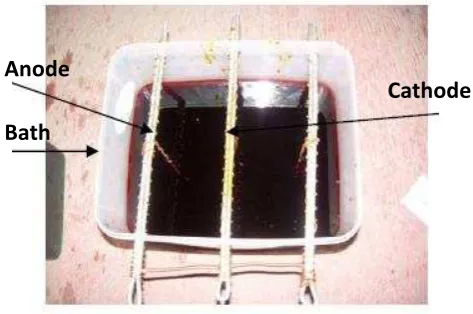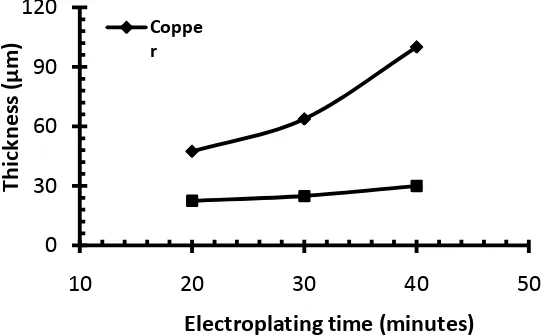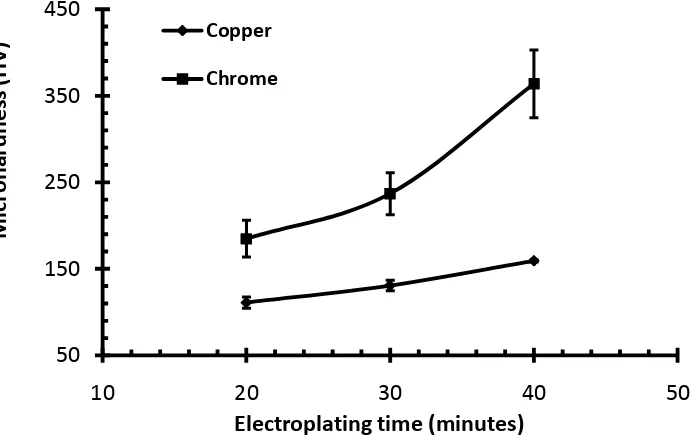Effect of Immersion Time on the Defect Formations
and Properties of theElectroplating Chrome
Masyrukan
#, Tri Widodo Besar Riyadi
#, Bibit Sugito
#, Yudit Novianto
## Faculty of Engineering, Universitas Muhammadiyah Surakarta, Jl. A. Yani Tromol Pos 1 Pabelan Kartasura
Surakarta, Jawa Tengah 57102, Indonesia
1
Abstract -The objective of this work was to investigate the effect of immersion timeon the mechanical properties and the defect formation in the electroplating chromium. A polymer was used as substrate, whereas cooper and nickel were used as underlayer materials prior to chrome plating. Three electrolyte solution bathswereprepared to plate copper, nickel, and chrome layers. The electroplating process was conducted using a current of 5 Ampere and a voltage of 12 Volt. The processing variable was carried outby varying the immersion time with20 minutes, 30 minutes, and 40 minutes.The morphology of thecross sectional surface of the product was observed using an optical microscope, whereas the mechanicalproperties were evaluated using a Vickers microhardness tester. The result demonstrates that the microhardness increases as the increase of the immersion time. However, by increasing the immersion timethere was a trend in the formation of fibrous defect found either in the body or interfacial adhesion between Cu/Ni/Cr layers. This defect was attributed to the thickness inhomogeneity of each layer.
Keywords–Plating, Cu/Ni/Cr, time, defects, hardness
I.INTRODUCTION
The rapidly developing technology in automotiveindustries has resulted a demand to reduce weight and fuel consumption. Polymeris a kind of plastic that has great potential to replace automotive components fabricated by conventional metallic materials [1]. The advantages of plastics are ease of fabrication, flexibility in design, and weight saving. Although a bright surface finish can be obtained by painting or moulding in colour parts, a reliable process is required to produce good decorative surface [2]. Recently, electroplating nickel/chrome was introduced to produce a high quality and bright reflective surfaces [1]. Electroplating chromes were available in different industries such as aircraft, vehicles, ships, and military sectors. Chrome has some distinct characteristics that are advantages in resisting wear. A thick chrome deposit provides additional wear surface, whereas thinner chrome is widely used for decorative coating. Electroplating chrome on a plastic therefore produces both bright finishes for decorative matter and wear resistance. Since polymer is a non-conductive material, metallization of non-conductive surface is therefore requiredas a method to convert non-conductive plastic surface into conductive by coating with metal seeded surfaces for a subsequent copper deposition [3].
The industry of electroplating plastic, however, experienced many difficulties to produce high quality product [4]. The major problem in the plating on plastic firstly came from the preparation stage in producing the initial adherent of metal which is electrically conductive material on the plastic surface which is non-conductive material. This step is the key factor in obtaining sufficient durability for the practical application of the chromed plastic. Some studies have reported that the adhesion of metal on a plastic surface has been overcome by pasting carbon prior to copper in the upper layer. Nickel was added in the next upper layer before chromium in the topcoat since it can be responsible for enhancing good corrosion resistance and supporting a lustrous metallic appearance. In a multilayer coating, however, adhesion between layers is of great concern. During plating, the thermal expansion mismatches between the layers may lead to the generation of a tiny crack. When the stresses become greater than the strength of the coating, it may develop a pattern of tiny cracks and the porosities. Thecrack often form an interlacing pattern to the base metal allowing corrosive liquid or gas to penetrate causing oxidation reaction. The objective of this work was to study the electroplating Cu/Ni/Cr on a polymer substrate. The effect of immersion time on the microstructure and the mechanical properties of the product were observed.
II.EXPERIMENTAL PROCEDURES
chromic acid 250 g/l, sulphuric acid 2.5 g/l, and kalium cyanide KC-15 10 g/l. The chemical compositions of the solution were determined by weighing each proportion in the weighing balance and subsequently dissolved in a specific volume of distilled water. The apparatus for the plating includes a plastic box used as the bath to contain the plating solution, and copper rod as the cathode. The anode was attached to the rectifier as the power supply, while copper wire was used to hang the steel sample. The schematic arrangement of the experiment is given in Fig. 1. Prior to electroplating process, the surface of the polymer was pasted using graphite manually. The process of electroplating was conducted varying the immersion time with 20, 30, and 40 minutes. After electroplating, the samples were rinsed in distilled water and dried. The surface of the product was then visually observed. The physical appearance of the surface and thickness of each layer were observed using an optical microscope. The thickness of the layer was also measured experimentally by subtracting the weight of thesamples before and after the electroplating. The different weight of the samples before and after electroplating was used to evaluate the average thickness of the layer by dividing the weight by the density of the layer material, and subsequently divided by the area of the samples. The mechanical properties was evaluated using a Vickers microhardness tester with diamond pyramid (136°) using a load of 300 gf and penetration time of 15 second.
Fig. 1 Electrolyte bath for chrome plating
III. RESULTS AND DISCUSSION A. Surface Morphology
After the samples were covered by graphite, the samples were plated using cooper and subsequently plated by nickel. Three immersion times for the electroplating cooper and nickel were varied by 20, 30, and 40 minutes. Fig. 2and Fig. 3show the surface of the samples after covered by cooper layer and nickel with three different immersion time,
respectively. The thickness of the cooper layer and nickel layerwere given in Fig. 5. The topcoat which is chrome layer was described in Fig. 4. It can be seen in Fig. 5 that an increase of the electroplating time increases the thickness of the layer. Comparing the deposition of copper and nickel, the deposition rate of copper is higher than that of the nickel. B. Microstructure
Fig. 6 shows the microstructure of the multilayer product observed in their cross sectional areas after plated using different immersion times. It was observed in all samples that the thickness of each layer is non-uniform. This is due the different factors affecting the deposition of the metal such as the non-uniformity of the graphite surface which was pasted manually, the current instability, and the condition of electrolite solution. The effect of immersion time on the electroplating copper, nickel, and chrome as given in Fig. 6 (a-c) revealed that the plating thickness increased with increasing immersion time. This is inline with Faraday’s second law of electrolysis. It was also observed in all samples in Fig. 6 that there was fibrous defect shaped like long cracks or scratches found either in the body of the coating or in the interfacial surface between the layers. An increase in the immersion time seems to reduce the quantity of the defect. Defective parts is not acceptable since it can produce losses and spoil the products image. The defect found in the body and interfacial of the coating has led to an insufficient adhesion and porosities. This is a danger for the material used as corrosion and oxidation resistances since air from outdoor can infiltrate into the metal substrate and may cause the oxidation reaction. When this defect appeared in the surface of the toplayer, it may reduce the attractiveness of the product.
C. Mechanical Properties
Fig. 7 shows the microhardness of copper and chrome layer after plated using electroplating time with 20, 30, and 40 minutes. The measurement was taken three times for each area in oder to improve the accuracy of the results. It can be seen that an increase in the immersion time increased the microhardness of the product either in copper or chrome layer. The microhardness of chrome is higher than that of the copper. The increase of the chrome hardness as the increase of the immersion time is higher than that of the copper. The hardnesses of copper for immersion time of 20, 30, and 40 were 110.77 ± 6.57 HV, 130.60 ± 6.03 HV, and 159.03 ± 1.41 HV, respectively. The hardnesses of the chrome for immersion time of 20, 30, and 40 were 184.73 ± 21.18 HV, 236.63 ± 24.17 HV, and 363.70 ± 39.18 HV, respectively.
IV. CONCLUSIONS
This work has reported a study of the electroplating Cu/Ni/Cr on a polymer substrate. Graphite was pasted manually on the polymer surface to convert the non-conductive material into non-conductive material. Three
Cathode
Anode
electrolyte baths were used to conduct the electroplating copper, nickel, and chrome. The effect of immersion time on the microstructure and mechanical properties were reported. It was observed that the thickness of each layer was non uniform. The fibrous defect was observed to appear either in the body of layer or in the interfacial between the layer.
ACKNOWLEDGEMENT
The authors are grateful to the Department of Mechanical Engineering, Faculty of Engineering, Universitas Muhammadiyah Surakarta – Indonesia.
REFERENCES
[I]. Beata Szolnoki et al, ‘’Development of natural fibre
reinforced flame retarded epoxy resin composites’’,
Polymer Degradation and Stability 119 (2015) 68-76 [II]. Ron Parkinson, Tony Hart, ‘’ Electroplating on
Plastics, Nickel Development Institute, Technical series no. 10078, Nov 1995
[III]. Dapeng Li, Kate Goodwin, Chen-Lu Yang,
‘’Electroless copper deposition on aluminum-seeded
ABS plastics’’, J Mater Sci, Springer Science, 30 September 2008
[image:3.595.78.489.259.381.2][IV]. Dong Ho Kang and Jin Chul Choi, An Environment-Friendly Surface Pretreatment of ABS Plastic for Electroless Plating Using Chemical Foaming Agents, Transactions On Electrical And Electronic Materials, Vol. 11, No. 4, pp. 174-177, August 25, 2010
[image:3.595.83.509.405.535.2]Fig. 2 Copperlayer deposited by electroplating time of: (a) 20 minutes, (b) 30 minutes, and (c) 40 minutes
Fig. 3 Nickel layer deposited by electroplating time of: (a) 20 minutes, (b) 30 minutes, and (c) 40 minutes
Fig. 4 Chrome layer deposited by electroplating time of: (a) 20 minutes, (b) 30 minutes, and (c) 40 minutes
(b)
(b)
(b)
(a)
(a)
(a)
(c)
[image:3.595.88.509.558.688.2]Fig. 5 Thickness of copper and nickel underlaying chrome plated using different immersion times
0
30
60
90
120
10
20
30
40
50
T
h
ic
kn
e
ss
(
µ
m
)
Electroplating time (minutes)
Coppe r
Chrome Nickel
Copper
50 μm
Chrome Nickel
Copper
(b)
Fig. 6 The optical microstructure of the Cr/Ni/Co layers electroplated for (a) 20 minutes, (b) 30 minutes, and (c) 40 minutes
Fig. 7 Hardness of copper and chrome layerselectroplated for three different immersion times
50
150
250
350
450
10
20
30
40
50
M
ic
ro
h
a
rd
n
e
ss
(
H
V
)
Electroplating time (minutes)
Copper
Chrome
(c)
Chrome Nickel
Copper



